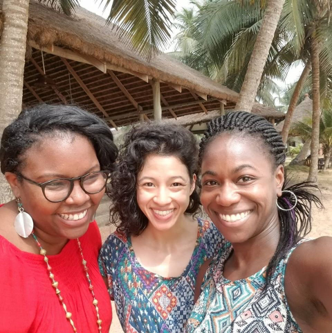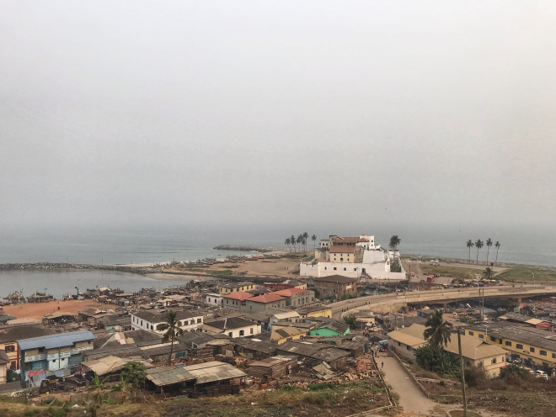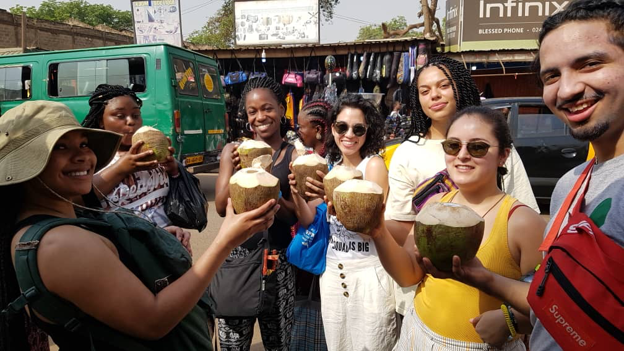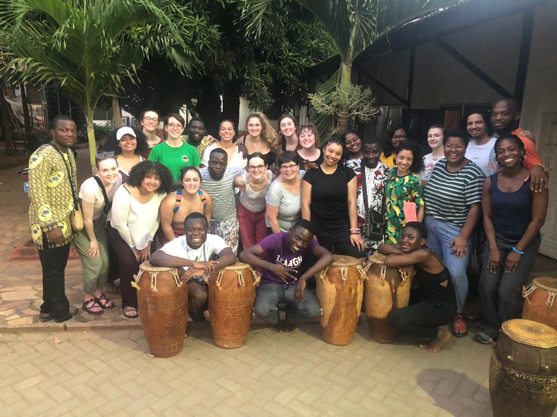Reflections on Race, Space, and Socialization
Vivie Nguyen; Director for Intercultural Engagement
It has been one month since we returned from Ghana, and I still find myself processing our time together- which I imagine, will be indefinite to some end. First and foremost, I wish to thank my sister friends LaToya Brackett (that’s Dr. Brackett to you!) for leading the way (without her there is no Ghana experience) and trusting me to bring along; and Khalila Fordham (Dr. Fordham, dependent on relationship)- for her openness to process with me each step of the trip. Second, immense appreciation goes to Drs. Juli McGruder and Kirsten Wilbur for their care and compassion, and providing me with timely comedic relief and understanding. Finally, and more than anything, I send my love to the students who kept me honest, authentic, and whole. Thank you to the readers of our blog and entering the sphere of what the African American Studies 310 students worked so tirelessly on.
My contribution to this blog is an attempt to talk through themes of how I have conceptualized my observations and internal processing in Ghana: Reflections on Race, Space, and Socialization. As an Asian American woman of color (among a myriad of other identities) and the Director for Intercultural Engagement at the University of Puget Sound, I am in a constant state of learning, unlearning, authenticity, and accountability. Many mistakes were made on my end on this trip, and I am deeply grateful for others who supported my growth and trusted me with their stories on my journey to be and do better. The following reflections are informed and interpreted through my own racial lens, positionality, and how I have been and am socialized- it is only a single thread of 20 other stories on this trip.
Race

There is what we
learn in the classroom, in an intellectual capacity, and there is the
translation of academic and activist knowledge to intrapersonal and
interpersonal relationships. Succinctly stated, I like to delineate this
difference as philosophy versus practice- the “read about it” and “be about it”
are not always aligned- when that dissonance occurs or is brought to light, it
sometimes shows up ugly. It is one thing to be abstractly and academically
aware of systems of race and power, it is entirely another layer to see
yourself as part of that system at every moment, in every interaction. My best
guess is that we often do not discuss within ourselves and among others how
race plays out in our relationships. Perhaps, our intellect and lexicon
of social justice jargon serves as translucent armor to set aside the actual
work of grappling with how and what we represent- at times, who we are- as the
tools and mechanisms of systems that intend to and continue to harm others
through anti-Blackness in all communities, and the entitlement (simply defined
as the right to have) that comes with socialization in a White, Western society.
Neither being Black nor White- I certainly grappled before and during the trip
with the fact that I could not provide a full sense of seeing and supporting
the racial identity process of most students, and even my own friends, of these
identities. The alignment or complicity of Asian Americans in relationship to
Black solidarity and White assimilation, respectively, is something I am in
constant conversation with myself and others over. Of course, this same personal
process occurs for me on campus and in my personal life, but this was an
extended trip that was entirely focused upon the creation and perpetuation of racial
stratification and oppression.
What did it mean when someone shared concerns with me versus their professor, a Black woman? Does my perceived approachability as an Asian woman (a result of my proximity to who is acceptable to White society) inadvertently undermine the authority of a Black woman leader of this trip? How did I show support when my Black friends entered spaces so significant to their stories, steeped in horrific histories that remain present and pervasive? Would my attempts to show compassion (Do I step closer? Do I offer a hug? Do I l loiter?) stem from my own discomfort to sit in, and simultaneous ability to, excuse myself from the history and impact of slavery? When did I lean into White assimilation and distancing; when did I truly show solidarity?
Was I, in these instances, the ignorant friend whose well-intentioned words and actions created harm- further widening the chasm across interracial relationships? Oftentimes, staff, students, and friends share stories with me of others who create circumstances of unintentional -and impactful- harm. My missteps and misspeaks during this trip served as a mirror and reminder that I also am, always, that person who harms. That negotiation of race, space, and socialization is incredibly awkward and often painful. The gift of honesty from others and my internal dialogue were an immensely humbling and fruitful place to grow and reflect on my own positionality and the impact on those who are more marginalized and oppressed than my social identities. In contrast, I also felt that I maybe “missed” something significant from not spending more time in the White affinity processing spaces- But where was this thought coming from? Would my presence and voice help or hinder White racial identity development and allyship?
In navigating this “in-between”, I found welcomed and surprising solace in affinity spaces and casual conversations with the non-Black students of color on this trip and how we each were processing our attempts to be in solidarity with Black people; negotiating anti-Blackness in our families and communities; and, our reactions and relationships to Whiteness throughout this trip.
Space
I noticed what I can only describe as an awkwardness in how dominant identities (in this case, White persons) negotiated “giving” space to those who are minoritized and marginalized in society (persons of color). I intentionally use the word give, as it insinuates those who typically “have” being able to step back to provide something that others typically “do not have.” There was a noticeable focus for White people on tangible and somewhat controllable aspects of space and capital such as time structure/schedules; when to speak in conversation; what material goods to purchase and from where; with physical space in relation to people of color being (perceived by me) as more difficult to negotiate.

When non-Black students of color were encouraged to experience the slave river and slave castles before White folks, at times, we felt rushed or hyper-visible to the White affinity group* (see footnote for affinity group context); with that, students of color felt appreciative to be able to take up space and see in a way that has not been afforded in the majority of their lives. In my reality, I felt that it was made quite obvious that space was being “given” (e.g. substantial sidestepping, parting of paths to let others forward) and negotiated rather than an organic allowance or flow for people of color to dictate both the space and the pace of movement throughout our tours and time in the slave river and castles. Ultimately, this is likely of no conscious fault or intention of anyone- I believe this has to do with how we are socialized to take up (or make ourselves smaller) in shared spaces. Kind of like an exaggerated version of who gets out of the way when we’re walking on the sidewalk or when we need a seat in public transportation, and who doesn’t.

On a predominantly White campus, our identities as people of color are not often called into question (you are that, racialized as that, treated as that). To overgeneralize, and most certainly because I spent more time with students of color on this trip, I noticed a greater focus on intangible (existential, personal) aspects of space in students of color compared to White students. When I say tangible concepts of space, I am speaking to aspects that one can physically quantify or observe (e.g. as aforementioned with White students, this manifested as a focus on schedules, speaking, and money spent) whereas intangible space I am offering as aligned with internal and personal dialogues of “Who am I in this space?” “How does being in another country impact my racial identity?” “How does my racial identity come up in community with or on the outside of other people of color?”
What does it mean to be a non-Black person of color on a trip of return for those of Black ancestry? To have to grapple with being a beneficiary of systems of slavery in the U.S. as a non-White person? For our refugee and immigrant families to have had a “choice” to come to the United States, but through the ravages of war? Processing having an in-between positionality and racial identity to Black and White communities both in life and on this trip.
As I did not spend the majority of my time in the Black affinity group, and again, not holding Black as my own racial identity- I want to frame the following as my interpretation of potential Black narratives. What does Blackness mean in another country that has no conceptualization of “Black”? Who am I in a space of my heritage and history- which was stolen, and seeing and experiencing it for the first time? Am I Black enough? When I return to a predominantly White space, am I enough? Is there any space- anywhere- I can be all my identities at once, and belong? The liberation and intimacy of being in sacred spaces as Black people without White voyeurism.
Socialization
About halfway into the trip, I felt a refocus on socialization, versus addressing individual behaviors and comments tied to racial identity, in process spaces could be beneficial. Utilizing a broader framework on how socialization creates what I could only call “cultural clashes” among racial groups allowed students to see how their upbringing influences how they take up and show up in shared interracial spaces. Conceptualizing how people take up and give space; advocacy for individual needs versus putting the community first; and, conveying deference to “elders” (which would be the 30+ year old leaders on this trip- Eesh. It’s me) could partially be captured through differences in socialization and upbringing in an individualistic society versus collectivistic culture.

All of us have been socialized in the United States, which is an individualistic society (as most Western and Eurocentric countries are)- where one advocates for their own needs (such as self-care); takes up space (from getting a seat at the table to moving up to the first row of a concert- or in our case, cultural and sacred sites); and, questioning authority is both healthy and encouraged. However, immigrant/refugee families and communities of color tend to have collectivistic cultural values which they continue to adhere to despite U.S. socialization such as honoring and obedience to social order (an example for us would be more flexibility from students of color to the daily schedule that is determined by the trip leaders); putting the needs of the whole first (we witnessed this in how both the non-Black POC students and the Black students similarly talked through “protection from White voyeurism” for one another in deciding racial affinity groups for sites of slavery); selflessness (this showed up as taking care and checking in with one another); and, familial ties/an interconnectedness. Oftentimes, communities of color experience a kinship when they are not in mixed company, and this much seemed true of this trip in POC and Black affinity spaces
Well Wishes
What I wish for all the students is that they felt a sense of connection to themselves as complicated, racial beings, and to others on this trip- no matter how challenging moments of consciousness raising can be. I hope that all of what we learned through the classroom and in Ghana is practiced on a personal level- that we truly begin to build authentic relationships across race, which requires conversations and accountability on how our social identities show up in our friendships and commitments to seeing and being with one another. I will forever be grateful for and indebted to this trip and experience, and I thank you all (including readers) for bringing it all to life.
*Racial affinity groups were used as intentional processing spaces during scheduled debrief sessions and sites throughout this trip. The majority of the trip was spent as a greater group. The reasoning for racial affinity groups is that this trip was deeply tied to our own racial identities. The Year of Return is for those of African ancestry. Then, there are those who may have ancestry tied to slavery through their White identity and certainly, how White dominance has historically and is still used in the U.S. to disenfranchise communities of color. Finally, there is the in-between identity which I spoke of earlier (neither Black nor White).
What is a racial affinity group? An affinity group is a group of people who share similar interests or goals. A racial affinity group then is a group of people who share similar racial identities. A common question or resistance to the existence of racial affinity groups is “Isn’t this self-segregation? Is this a form of reverse racism?”
Without getting into an entire lecture, I simply want to offer my own interpretation. Racism and segregation (as a tool to perpetuate racism) are systems that give power to dominant identities (in the case of the United States, White people). Segregation was and is a way to keep people of color away from, excluded by, and without access to the privileges that White people possess without race being a barrier (wealth, education, social mobility). When people of color gather together in a space, this is a form of solidarity (unity). People of color do not have the power to keep White people out of any systemic form of privilege or power; with that said, how would a racial affinity group for Black people and/or POC “harm” or “exclude” White people from their daily lives and abilities? It does not.
Racial affinity groups for marginalized/minoritized identities might make White people feel they are not entitled to a singular space, which is perhaps a new concept for them (comparative to those who have been historically and presently excluded, or, are the only person of color in the office or classroom)- but it does not take anything tied to power or privilege away. What MIGHT be taken away when people of color are in solidarity spaces together is the ability for White people to “learn from people of color” through a voyeuristic or exploitative lens, versus one founded on authentic relationship. Food for thought.